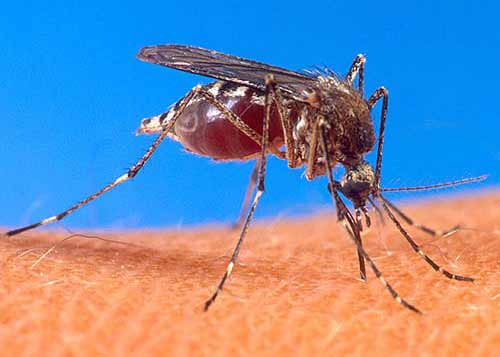Bug Love: Mosquitoes Sing Duet in Harmony

The buzzing of mosquitoes annoys us, but it sounds sweet to the insects' potential mates. In one species, mates are capable of harmonizing, performing love duets by subtly adjusting their buzz frequencies.
The mosquito duet was discovered in a recent study of Aedes aegypti, the species that carries and transmits the viruses that cause human dengue and yellow fever.
The researchers say their results, which are published today in an early online edition of the journal Science, have implications for preventing the spread of such diseases.
Mosquito duets
In the study, Ronald Hoy of Cornell University in New York and his colleagues tethered individual A. aegypti mosquitoes to the ends of insect pins and recorded wing-flapping frequencies. Mosquitoes produce their signature buzzes by flapping their wings at different speeds per second.
The male's wing-beat frequency (also called its fundamental frequency) ranged from about 550 to 650 Hertz while the female's ranged from 350 to 450 Hz (or wing beats per second).
When a tethered female mosquito was moved past a stationary male, the wing-flapping frequencies, and thus the buzzing sounds, changed a tiny bit, the researchers observed.
Sign up for the Live Science daily newsletter now
Get the world’s most fascinating discoveries delivered straight to your inbox.
In nearly 70 percent of the pairs, both mosquitoes adjusted their wing-flapping speeds (fundamental frequency) so that their so-called harmonics matched up in a particular way. A harmonic is a multiple of a fundamental frequency. So the second harmonic of 430 Hz would be 860 Hz.
Basically, any time a mosquito buzzes, it generates a fundamental tone based on wing beats per second. But in addition to that dominant "buzz," harmonics are naturally generated. The same happens when a musician strikes a key on a piano or strums a chord on a guitar.
The A. aegypti mosquitoes changed their wing-flapping so that the male's second harmonic (two times its wing-beat frequency) matched the female's third harmonic. The result was a kind of mating duet of around 1,200 Hz.
Other tests of the mosquitoes' "ears," called the Johnston's organ, revealed the whining insects can detect frequencies at least as high as 2,000 Hz. Until now, scientists thought a male mosquito's hearing range went from about 300 to 800 Hz.
Choosy females
The researchers speculate this tone-matching is a form of sexual selection in which the females are testing the male's fitness before mating.
"We think what the females are doing is saying, 'Can you match this harmonic, and how fast does it take you to match it?'" Hoy told LiveScience. "If the male is slow or doesn't match it, she'll just fly away."
The results could have implications for stemming the spread of mosquito-borne infectious diseases. One prevention idea has been to breed and release loads of sterile male mosquitoes into the wild. Thus, mating would result in no offspring and so there would be fewer disease-carrying insects. (Once a female A. aegypti mates, it will not mate again for at least a week, Hoy said. And such mosquitoes only live a matter of days or weeks.)
But if this sterilization process also eliminates a male's ability to match up harmonics at 1,200 Hz, the A. aegypti females will reject that male, and the sterilization process won't work. So the mosquito love songs could be a test for whether a sterile male is a "stud or a dud," Hoy said.
Jeanna Bryner is managing editor of Scientific American. Previously she was editor in chief of Live Science and, prior to that, an editor at Scholastic's Science World magazine. Bryner has an English degree from Salisbury University, a master's degree in biogeochemistry and environmental sciences from the University of Maryland and a graduate science journalism degree from New York University. She has worked as a biologist in Florida, where she monitored wetlands and did field surveys for endangered species, including the gorgeous Florida Scrub Jay. She also received an ocean sciences journalism fellowship from the Woods Hole Oceanographic Institution. She is a firm believer that science is for everyone and that just about everything can be viewed through the lens of science.









